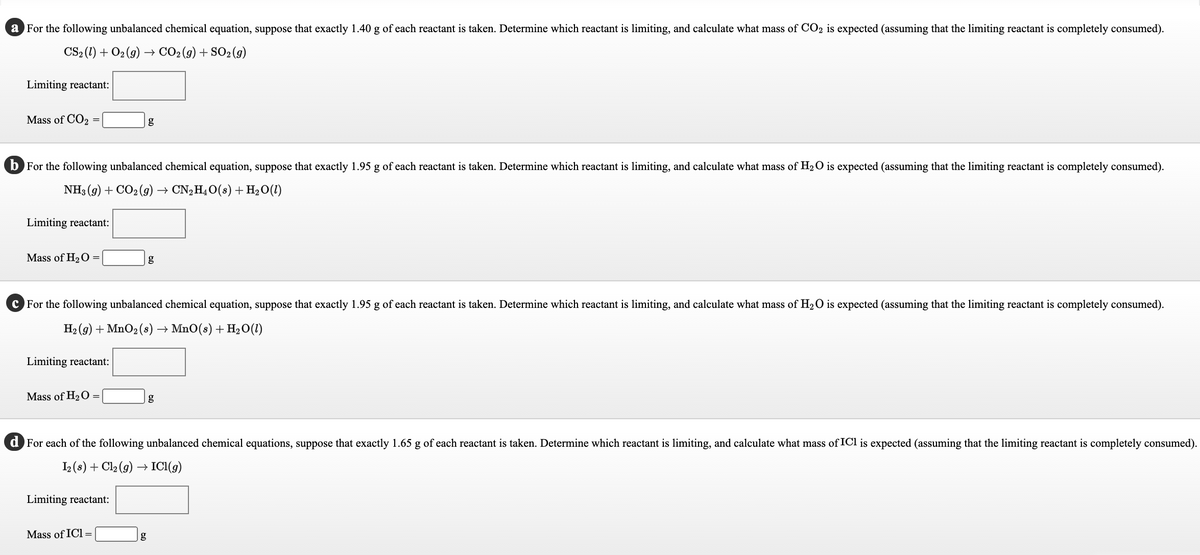For the following unbalanced chemical equation, suppose that exactly 1.40 g of each reactant is taken. Determine which reactant is limiting, and calculate what mass of CO2 is expected (assuming that the limiting reactant is completely consumed). CS: (1) + O2(9) → CO2(9) + SO2(9) Limiting reactant: Mass of CO2 = For the following unbalanced chemical equation, suppose that exactly 1.95 g of each reactant is taken. Determine which reactant is limiting, and calculate what mass of H2O is expected (assuming that the limiting reactant is completely consumed). NH3 (9) + CO2(9) → CN;H,O(s) + H2O(1) Limiting reactant: Mass of H20 = For the following unbalanced chemical equation, suppose that exactly 1.95 g of each reactant is taken. Determine which reactant is limiting, and calculate what mass of H2O is expected (assuming that the limiting reactant is completely consumed). H2(9) + MnO2(s) → MnO(s) + H2O(1) Limiting reactant: Mass of H20 =| For each of the following unbalanced chemical equations, suppose that exactly 1.65 g of each reactant is taken. Determine which reactant is limiting, and calculate what mass of ICI is expected (assuming that the limiting reactant is completely consumed L(s) + Cl2(9) → ICI(9) Limiting reactant: Mace of ICL -
For the following unbalanced chemical equation, suppose that exactly 1.40 g of each reactant is taken. Determine which reactant is limiting, and calculate what mass of CO2 is expected (assuming that the limiting reactant is completely consumed). CS: (1) + O2(9) → CO2(9) + SO2(9) Limiting reactant: Mass of CO2 = For the following unbalanced chemical equation, suppose that exactly 1.95 g of each reactant is taken. Determine which reactant is limiting, and calculate what mass of H2O is expected (assuming that the limiting reactant is completely consumed). NH3 (9) + CO2(9) → CN;H,O(s) + H2O(1) Limiting reactant: Mass of H20 = For the following unbalanced chemical equation, suppose that exactly 1.95 g of each reactant is taken. Determine which reactant is limiting, and calculate what mass of H2O is expected (assuming that the limiting reactant is completely consumed). H2(9) + MnO2(s) → MnO(s) + H2O(1) Limiting reactant: Mass of H20 =| For each of the following unbalanced chemical equations, suppose that exactly 1.65 g of each reactant is taken. Determine which reactant is limiting, and calculate what mass of ICI is expected (assuming that the limiting reactant is completely consumed L(s) + Cl2(9) → ICI(9) Limiting reactant: Mace of ICL -
Introductory Chemistry: A Foundation
9th Edition
ISBN:9781337399425
Author:Steven S. Zumdahl, Donald J. DeCoste
Publisher:Steven S. Zumdahl, Donald J. DeCoste
Chapter9: Chemical Quantities
Section: Chapter Questions
Problem 44QAP: Balance the following chemical equation, and then answer the question below....
Related questions
Question

Transcribed Image Text:a For the following unbalanced chemical equation, suppose that exactly 1.40 g of each reactant is taken. Determine which reactant is limiting, and calculate what mass of CO2 is expected (assuming that the limiting reactant is completely consumed).
CS2 (1) + O2 (9) → CO2(g) + SO2(9)
Limiting reactant:
Mass of CO2
g
b For the following unbalanced chemical equation, suppose that exactly 1.95 g of each reactant is taken. Determine which reactant is limiting, and calculate what mass of H2O is expected (assuming that the limiting reactant is completely consumed).
NH3 (9) + CO2 (g) → CN2H40(s) + H,O(1)
Limiting reactant:
Mass of H2 O =
g
C For the following unbalanced chemical equation, suppose that exactly 1.95 g of each reactant is taken. Determine which reactant is limiting, and calculate what mass of H2O is expected (assuming that the limiting reactant is completely consumed).
H2 (g) + MnO2(s) → MnO(s) +H2O(1)
Limiting reactant:
Mass of H2 0 =
g
d For each of the following unbalanced chemical equations, suppose that exactly 1.65 g of each reactant is taken. Determine which reactant is limiting, and calculate what mass of ICl is expected (assuming that the limiting reactant is completely consumed).
I2 (s) + Cl2 (9) → ICI(g)
Limiting reactant:
Mass of ICl =
|g
Expert Solution
This question has been solved!
Explore an expertly crafted, step-by-step solution for a thorough understanding of key concepts.
This is a popular solution!
Trending now
This is a popular solution!
Step by step
Solved in 2 steps with 2 images

Knowledge Booster
Learn more about
Need a deep-dive on the concept behind this application? Look no further. Learn more about this topic, chemistry and related others by exploring similar questions and additional content below.Recommended textbooks for you

Introductory Chemistry: A Foundation
Chemistry
ISBN:
9781337399425
Author:
Steven S. Zumdahl, Donald J. DeCoste
Publisher:
Cengage Learning

Chemistry: The Molecular Science
Chemistry
ISBN:
9781285199047
Author:
John W. Moore, Conrad L. Stanitski
Publisher:
Cengage Learning

Chemistry for Engineering Students
Chemistry
ISBN:
9781337398909
Author:
Lawrence S. Brown, Tom Holme
Publisher:
Cengage Learning

Introductory Chemistry: A Foundation
Chemistry
ISBN:
9781337399425
Author:
Steven S. Zumdahl, Donald J. DeCoste
Publisher:
Cengage Learning

Chemistry: The Molecular Science
Chemistry
ISBN:
9781285199047
Author:
John W. Moore, Conrad L. Stanitski
Publisher:
Cengage Learning

Chemistry for Engineering Students
Chemistry
ISBN:
9781337398909
Author:
Lawrence S. Brown, Tom Holme
Publisher:
Cengage Learning

Chemistry for Engineering Students
Chemistry
ISBN:
9781285199023
Author:
Lawrence S. Brown, Tom Holme
Publisher:
Cengage Learning

General Chemistry - Standalone book (MindTap Cour…
Chemistry
ISBN:
9781305580343
Author:
Steven D. Gammon, Ebbing, Darrell Ebbing, Steven D., Darrell; Gammon, Darrell Ebbing; Steven D. Gammon, Darrell D.; Gammon, Ebbing; Steven D. Gammon; Darrell
Publisher:
Cengage Learning

World of Chemistry
Chemistry
ISBN:
9780618562763
Author:
Steven S. Zumdahl
Publisher:
Houghton Mifflin College Div